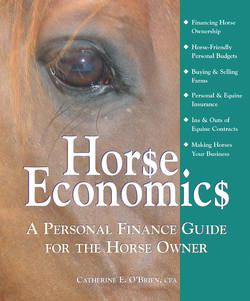Читать книгу Horse Economics - Catherine E O'Brien - Страница 37
На сайте Литреса книга снята с продажи.
SO YOU KNOW…
Оглавление♦ An agreed value clause amends loss settlement provisions to the full amount an animal is insured for at the time of the loss. To explain: if you wreck your car, you are not going to receive what you paid for the car from the insurance company, but rather its fair market value at the time of the accident. This is relatively easy to determine with the help of a common car-pricing guide; however, no such guide exists for horses. An agreed value clause eliminates the need to determine the fair market value of the horse at the time of loss by guaranteeing that if you insure your horse for $5,000 and he dies due to a covered event, the insurance company will pay you $5,000.
If your horse’s value is dependent on his ability to perform a specific function, such as jumping or racing, loss of use coverage can added to your equine mortality policy. This is similar to disability insurance for a person with an “own occupation” rider on his policy: if a heart surgeon is in a terrible car accident that crushes his hands and he can no longer perform intricate surgical procedures, his disability insurance will pay him a benefit. In the same way, if a horse can no longer perform his intended job, loss of use coverage pays the owner a benefit.
Medical/surgical policies are generally riders or attachments to mortality/theft policies, and offer coverage for veterinary bills and costs associated with a severe injury or illness. They do not cover routine veterinary care and vaccinations, travel expenses, elective surgery, or holistic treatments.
Insurance Overview
When considering insurance companies, it is best to shop around for the best rates and coverage available. Enlist an insurance agent licensed in your state to help you with your search. Make sure the company is financially sound by checking the financial strength ratings with an agency, such as A.M. Best or Standard & Poor’s. You can also review a company’s “complaint history” filed with your state’s department of insurance. Consumer information, guides, and booklets are available through your state and the National Association of Insurance Commissioners (NAIC). Contact information for the NAIC, the National Committee for Quality Assurance (NCQA), and rating agencies for life and long-term care insurance companies, can be found in Resources, p. 220.
Contact a property and casualty insurance agent for quotes on a personal horse owner’s liability policy with your desired limits of coverage, as well as equine mortality/theft and medical/surgical insurance. Premiums for these types of coverage depend upon the insurer’s underwriting guidelines, which may include the breed, age, sex, use, and purchase price of the horse, and your location. I’ve included information to help you locate equine insurance providers on p. 219.
Finally, read every policy thoroughly upon receipt and understand the terms and conditions contained therein. If there is anything that you don’t understand, it is important to call the insurer or agent with any questions before you have an event that could result in a claim. There are responsibilities the insured—you—must fulfill in order to maintain coverage.
